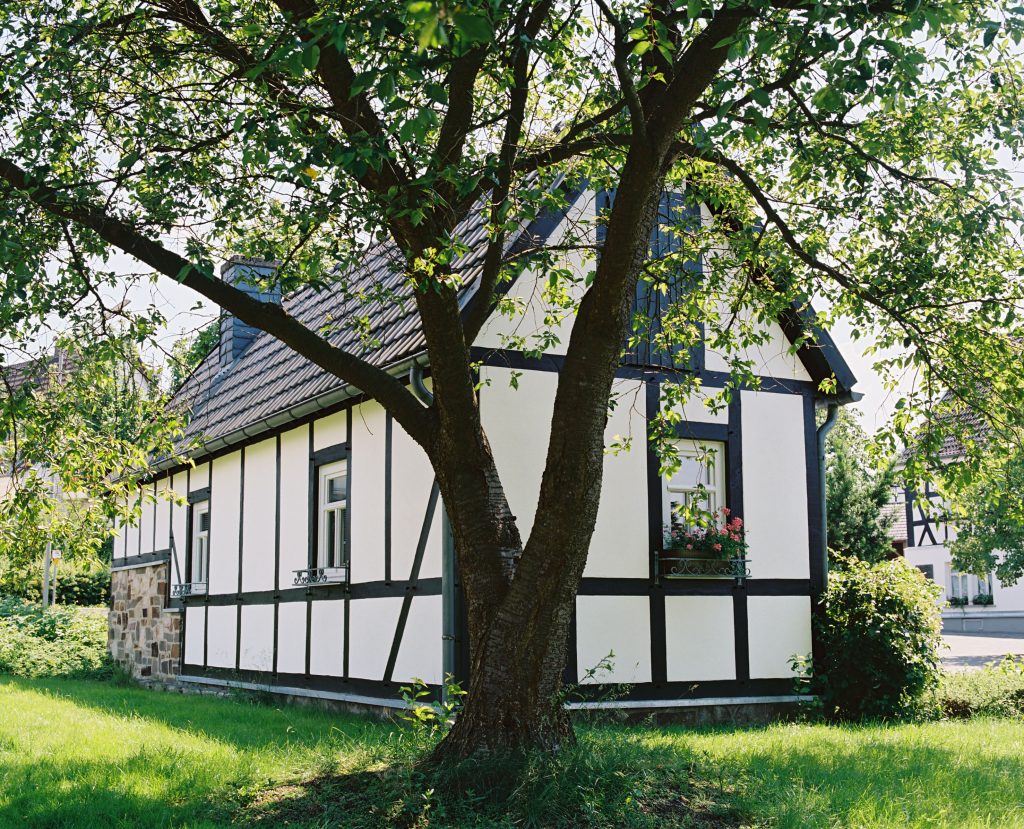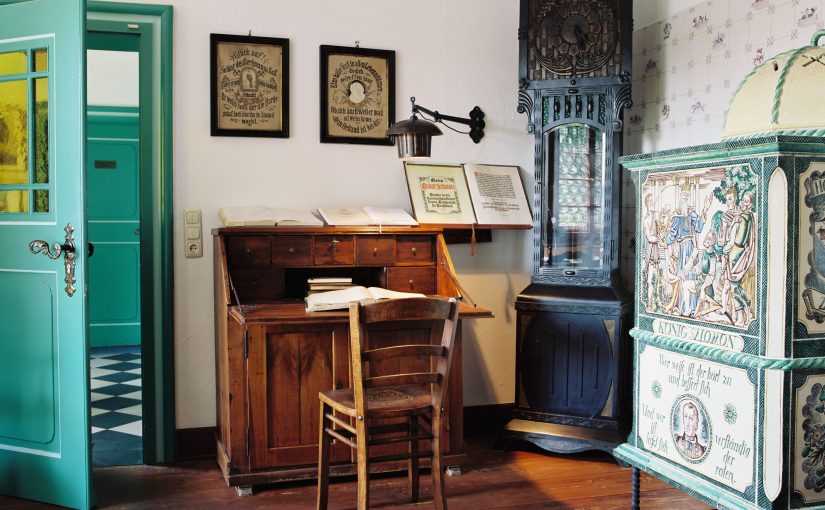Friedrich Wilhelm Raiffeisen is renowned as the co-founder of the co-operative finance and banking business that bears his name. His Christian roots have been somewhat forgotten.
Text: Michael Klein
Photos: Markus Haefke
There is a modern hymn that goes:
In water falls a stone, so gently with no sound / It falls in all alone, but circles spread around. / The love of God is great, it falls into our heart, / And spreads, in word and deed throughout the world in every part. / A tiny spark when fanned, turns into flame so bright / Those who in darkness stand, are drawn into the light …
(Evangelical hymnbook No 659)
This hymn by Manfred Siebald could very rightly be referred to as the “Raiffeisen song”, because for him, too, everything started out inconspicuously on a small scale, with a pious idea. An idea that today brings hundreds of millions of people together in co-operatives worldwide.
Raiffeisen was born in Hamm-on-Sieg on 30 March 1818, the seventh of nine children of Gottfried Raiffeisen, the village mayor, and his wife Amalia. Situated in Westerwald, the village, like the region, had come under the rule of the Kingdom of Prussia a few years earlier and Gottfried Raiffeisen now served there as the Prussian municipal chief officer. But there were soon complaints expressed over his administration. An unlawful interference in the poor relief fund was to cost him his office and burdened the family with debt for many years. It is against this dark background that the childhood of the young Friedrich Wilhelm was played out.
In these difficult financial circumstances, he learned practical life skills from his mother based on religious piety. His godfather, the local church minister, also took an interest in him. He was a man committed to social issues, who during the course of a local food shortage had established a mutual aid and benevolent society in Hamm. After Friedrich left the elementary school his godfather built on the education he had acquired there, so that at the age of seventeen he was successful in his application to enter the military. This was probably bound up with a plan to use military service as a means to getting qualifications for employment in administrative work. As a soldier he was transferred for specialist training as a “senior explosives expert”.
At that time Raiffeisen found a further focal point in his life in the friendship association “Euterpia” which had been founded by a group of his friends. Three of these went on to become theological students, with whom Raiffeisen was to develop lifelong friendships. Euterpia later formed the nucleus of the student fraternity “Wingolf”. Raiffeisen stayed in contact with his friends and received through this a wealth of intellectual stimulus.
As a soldier he worked in an iron foundry, which led to him developing an eye disorder, so that he had to leave military service early and shortly afterwards he was accepted for work in local municipal administration. In 1845 at the age of 27 he became mayor of Weyerbusch in the Westerwald region, along with its surrounding villages. Raiffeisen advocated an improvement of the infrastructure, which saw in particular the building of schools and roads.

In 1846/46 there was a winter of famine, which made particular demands on the young mayor. He ordered corn for his local citizens from the royal government. This was supplied, albeit on condition of immediate payment; something that was impossible for the impoverished people. So Raiffeisen gave out the corn – and later bread that was baked in a small bakery – on credit. Further supplies of corn were obtained. The financial liability for this was taken on by the members of the “bread association”, a society founded specifically for the purpose. This project was a great success and the mayor weathered the crisis very well.
Soon afterwards Raiffeisen was transferred to the neighbouring village of Flammersfeld and once again got to work on founding an association. The “benevolent society” there offered credit to farmers so that they would no longer be dependent on extortionate lenders. With the credit provided by the society the farmers could buy cattle or agricultural tools. Once again the society bore the liability and once again the granting of credit was a success.
In his next appointment as mayor in Heddesdorf on the Rhine, Raiffeisen’s idea of self-help was extended in 1852 to draw yet more districts into a “charitable society”. In addition to giving favourable credit loans, there came welfare provision for abandoned children, care of ex-prisoners and the founding of a community library. Raiffeisen worked on his ideas with a remarkable degree of consistency with those of the “Inner Mission” which had been initiated by Johann Hinrich Wichern a few years earlier. One of his lifelong friends, Revd Albrecht Julius Schöler, was to become a propogandist for the Inner Mission in the Rhineland at the same time as being a promoter of Raiffeisen’s ideas.
But by now Raiffeisen was running up against the limits of his possibilities. In the end, the only successful elements of his “charitable society” were the childcare service and the granting of credit. However, the latter had increased so much in volume that the members of the society who had hitherto offered unlimited liability now began to be nervous about their assets. Raiffeisen finally had to dissolve the society. In its place there appeared in 1864 a so-called loan society, which was conceived as a co-operative.
More than just obtaining credit
Lenders and borrowers were both now members of the society. A “loan society” such as this was limited to no more than the size of a local parish, for the purpose of better mutual social control. No dividends were given out and it was run by volunteers. A special feature was that the interest income from the credits that were granted was saved in an endowment fund, which was built up until it was enough to sponsor further social projects from it. In this way Raiffeisen’s plans went far beyond the idea of his societies just providing favourable means of obtaining credit. Much more than that, they engaged actively in the promotion of a sense of community. Raiffeisen drew up his own concrete vision when he specified what should be done with the resources that had been saved up in the endowment fund. He wrote:
“The profits subsequently generated each year would furnish abundant resources with which to set up institutions for improving the general welfare of the population, such as infant care hostels, advanced training schools for school-leavers, hospitals and sanatoriums, and asylums for the needy, old and infirm etc.”

Because of his eye disease, Raiffeisen had taken early retirement and was living in financially precarious circumstances, which meant that his societies provided him with a way of continuing work in the future. This came about not least through the distribution of practical guidelines which he had put together in 1866 for the foundation of “loan societies“, which quickly spread his ideas, at first in the Rhineland but then quickly throughout all German speaking regions and later much wider afield. In all of this it was always of decisive importance for Raiffeisen that wherever new societies were established, a religious dimension should be bound up with it. Without the involvement of the parish minister societies would be difficult to set up, with his opposition they could not be set up at all, he thought. Denominational questions had no role to play for him. What was crucial was the support of the parish minister. Raiffeisen saw this as an opportunity for them to come into closer contact with their local community. Through this they would recognise that economic concerns were not unrelated to spirituality.
Yet Raiffeisen was only successful in his work for a time. There remained a degree of discontent in terms of productivity. Raiffeisen refused to regard his societies simply as institutions offering favourable credit terms, nor did he see the centralised warehouses which he later developed simply as organisations for the favourable procurement of goods, or for the purpose of the profitable sale of local produce. Raiffeisen wanted much more than that. For him a decisive factor was the spiritual dimension. The societies should help people in their need, faithful to the Invitation of Jesus Christ: “Whatever you do to the least of the members of my family, you do to me.“ It is clear that for the founder of the society this was not a case of simple terminology or of metaphorical language but of the essential truth of his faith.
Not all the members of the co-operatives thought the same as Raiffeisen and he gave a lot of thought as to how the spiritual foundations of his work could be secured. He found two models for this: one was that of a community of people attached to the Franciscan Order who were actively involved in care for the sick without themselves being clergy. The other example was from his knowledge of the approach taken by the Herrnhut Brethren of not rejecting profit-making , but allowing it to provide for mission.
As a result, Raiffeisen established a trading company which was closely interconnected in its personnel with his co-operative activities. The profits of the company were to be put into his “mission“ i.e. the co-operative. From now on the staff would live as a community with the name “Caritas Society”. Raiffeisen hoped to find staff for his “co-operative mission” who were spiritually suitable for this. Even though the plans were not entirely fulfilled, it still shows how Raiffeisen continued to work on such ideas right up to his death, as was confirmed later.
Deeply rooted in spirituality
At the annual meetings of his co-operatives, Raiffeisen increasingly turned into someone issuing uncomfortable warnings. He found it completely natural to point to Jesus‘ call to care for the “least of the members of my family” in the parable of the Last Judgment (Matt 25) as being the “basis for the loan societies and the way in which they are organised.” Here again the deep spiritual roots of his activities are evident. Naturally, this directly religious frame of reference, which defined the co-operatives solely as a religiously motivated activity, was not the general perception of the whole of the co-operative association. In a certain sense, “Father Raiffeisen” as he was now known in the co-operative movement, was put on a pedestal. However, in the shadow of this monument there were actually many different views about it, other than the somewhat uncomfortable religiosity of the founder.
In church circles there was evident interest in Raiffeisen’s fundamental attitude as a believer. Although one of the friends of his youth, Revd Schöler, had already tried to draw Raiffeisen’s attention to this possibility, it was tried again later with more resounding success by Revd Adolf Wuttig. As a young minister he had taken responsibility for the Evangelical parish of Frankenheim in Thuringia. People there were in slavery to extortionate debt bondage. The situation seemed so hopeless that the Grand Duke’s government in Sachsen-Meiningen proposed shipping the people to America at the State’s expense, and then tearing down the village. But the young minister succeeded in turning the village into a flourishing debt-free community, which achieved a certain degree of prosperity through the addition of a brush factory and a hotel for summer visitors.
All of this led Revd Wuttig to attribute his successful work back to Raiffeisen-style associations. And so he spread the information about his positive experience around church circles and committees. His initiative to grant Raiffeisen an honorary doctorate on his 70th birthday did not materialise, as the founder of the co-operative movement died a few days beforehand, on 11 March 1888.
In the meantime, the Inner Mission, as the predecessor of today’s Diaconal Service, showed an interest in Raiffeisen’s co-operatives. In the year of his death in 1888 the “Inner Mission Congress” considered the topic for the first time. It was in Posen seven years later that they expressly adopted the work of co-operatives according to Raiffeisen’s ideas and included it in their diaconal sector. It was formally resolved:
“We welcome the Raiffeisen loan societies, organised according to Friedrich Wilhelm Raiffeisen, as a genuinely Christian endeavour in which practical social reform is pursued actively and truthfully in the Christian spirit. These associations are Christian in origin (the dedicated Christian personality of “Father Raiffeisen” and the Christian-ethical principles incorporated in the regular statutes of the associations), they provide Christian works of charity (solidarity-based liability interpreted on the basis of Christian principles, parish-based structure, unpaid management, prudent and purposeful lending to promote the borrower ́s Christian ethics, fund-raising for the joint endowment fund) and pursue Christian objectives (revitalising a Christian sense of community, imposing spiritual discipline, preventing decay and impoverishment, supporting the people ́s welfare). (…) The work of Raiffeisen has found a home in the multi-layered structure of the Inner Mission.”
As a result, Raiffeisen and his co-operatives were for a long time highly respected as part of Protestant life. Throughout the many states and provinces of the German Empire Raiffeisen-style work was integrated into the individual associations for Inner Mission in each place. Innumerable annual reports in the church archives show their accounts. For example in the report of the Inner Mission in the Duchy of Gotha in 1909: “The Raiffeisen loan societies are happy to report a generally healthy growth, and in addition to bringing a recovery in economic conditions they offer training in philanthropy and lessons in community responsibility and practical welfare work. They are increasingly able to transfer part of their financial gains over to community welfare, and indeed (the society in) Finsterbergen has accumulated considerable capital assets, the interest on which is used for the purposes of the Inner Mission.”
Even in theological terms “Raiffeisen” appeared around the beginning of the last century in a handbook of practical theology, with the description of the founding of a “loan society”. Unfortunately after the First World War the interest in the work faded. In particular, clergy who were influenced by the dialectic theology of Karl Barth regarded involvement in Raiffeisen societies as unsuitable work for a minister and therefore also unnecessary. For that reason the once close links of the church with Raiffeisen were quickly forgotten.
In the year of the bicentenary of Raiffeisen’s birth the founder of the co-operatives will be commemorated in many places. His ideas – returning to the images in the hymn quoted at the beginning – made “circles spread around” and the spark of his fervent faith kindled “flame so bright”. It all started with a pious idea.
ABOUT THE AUTHOR
Michael Klein, born 1964, is minister of the Evangelical parish of Hamm-on-Sieg, the very place where Raiffeisen was born. Michael Klein wrote his doctoral thesis on Raiffeisen and in addition to serving as a minister he is a visiting professor of church history at the Univeristy of Heidelberg.

0 Kommentare zu “It all started with a pious idea”